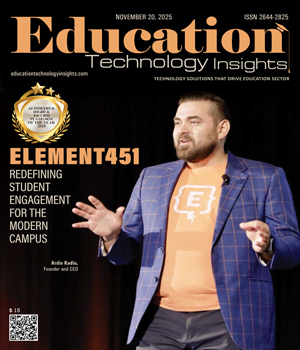THANK YOU FOR SUBSCRIBING
Be first to read the latest tech news, Industry Leader's Insights, and CIO interviews of medium and large enterprises exclusively from Education Technology Insights
Will Intelligent Tutoring Systems Transform Education?
Rob Theriault, Immersive Technology Manager, Georgian College
 Rob Theriault, Immersive Technology Manager, Georgian College
Rob Theriault, Immersive Technology Manager, Georgian College
Rob has a Master of Educational Technology from the University of British Columbia. He is a published author, researcher, International speaker, and the recipient of the Virtual World Society’s Nextant Global Educator Prize as a global thought leader in the XR space.
In education, two technological tsunami events have hit the shorelines of education and are merging to change how students learn and how learning is assessed. These two waves are XR and AI. XR is an umbrella term for virtual reality (VR), mixed reality (MR) and augmented reality (AR). Unlike any other educational technology, these technologies provide a medium for learning in the cognitive, psychomotor, and affective domains - visual, auditory, emotionally provocative, tactile, and experiential learning. Among its many superpowers, spatial and social presence, context and agency are key elements to embodied learning. For example, when buildings are to scale, spatial presence is particularly valuable when architectural students learn design and can get a “real” perspective. One architectural firm was tasked with designing a children's hospital, and the architects shrunk their avatars to the height of a five-year-old to see the design from a child’s perspective. This would otherwise be impossible in the real world. Social presence in VR/MR, when real people in avatar form can see eye to eye and speak to each other, is far more intimate than a video call. Students and their teachers feel connected in ways previously impossible from a distance. In medical simulations, seeing a sick patient in VR can elicit an emotional response needed to help students understand the urgency of the patient encounter. It can also evoke an empathetic and compassionate response, allowing the teacher to guide the student’s response in a way that provides reassurance without giving false hope. Context is valuable for all subject areas, from nursing to engineering, but particularly for subjects like language and history. The research has shown that students retain information better when immersed in a context rich environment. Finally, agency, especially when students can do things with their hands, such as electrical work or surgery, enhances learning to a new level, reducing training time and improving retention and safety.
"At Georgian College, besides exploring and integrating XR in over thirty programs, we are also exploring the intersection of XR and AI to develop Intelligent Tutoring Systems (ITS) where, for example, a student can wear XR glasses, look at an anatomical model and have an in-depth discussion with the AI"
AI, and more precisely multimodal Generative AI (GenAI), combined with computer vision, is comparatively new and has educational institutions going through an academic integrity crisis. Simultaneously, many teachers and students are leveraging GenAI to improve learning and create efficiencies in their work. While these two areas of concern and optimization are important to discuss and address, an equally important opportunity is at hand that schools need to explore to remain relevant. That is, how will XR and AI help change the way students learn and assess learning?
At Georgian College, besides exploring and integrating XR in over thirty programs, we are also exploring the intersection of XR and AI to develop Intelligent Tutoring Systems (ITS) where, for example, a student can wear XR glasses, look at an anatomical model and have an in-depth discussion with the AI. Imagine the following scenario: A student, wearing augmented reality glasses enhanced with AI, stands in front of an anatomical model, points to and asks for the name and function of an organ. The AI answers, of course, but also knows the student’s learning objectives, so it tailors the answer to the right depth and breadth. However, the AI is not restricted to the depth and breadth of the learning objectives, so the student can probe deeper, as any teacher would want to encourage curiosity. At some point and at regular intervals, the AI will ask the student questions to ascertain what they know, understand, and can apply. In doing so, the AI provides feedback and remedial learning and is able to produce a report that can be used as a summative assessment. In addition, when the student asks for further clarification on a topic, the AI may offer a visual aid, such as an image of the inside of an organ. It does so by using the AI’s ability to generate images and the student’s augmented reality glasses to present an image, either 2D or ideally 3D, in the student’s field of view. If the student probes deeper, perhaps asking about the clinical applications of a disease affecting the organ in question, the AI might suggest putting on a pair of VR glasses to take the student into an immersive hospital setting to see how a patient might appear at various stages of the disease.
Intelligent Tutoring Systems that combine XR and AI have the potential to do the heavy lifting of Bloom’s taxonomy, enabling schools to shift from a grades-based system to a competency-based system and freeing the teacher to spend more time in the classroom to do cased based learning, project-based learning, critical thinking activities, and interpersonal skills development.
Read Also
Leading Through Change in the AI First Era: The New Leadership Skillset
The Importance of UX in E-Learning Courses
Designing Opportunity for All
Goldilocks Regulation
Beyond the Quiz: Redefining Competence in eLearning
Beyond Theory and Into Monday Morning: Enhancing Graduate Programs for Teachers

I agree We use cookies on this website to enhance your user experience. By clicking any link on this page you are giving your consent for us to set cookies. More info






















